Reviews
Midareru
Mikio Naruse
Japan, 1964
Credits
Review by Ian Johnston
Posted on 28 November 2007
Source VHS
Categories Flowing: The Films of Mikio Naruse
The quiet, underplayed, “invisible” style of Naruse’s films of the fifties and sixties has often been remarked on—the late, great Edward Yang has even described him, in contrast to Ozu and Kurosawa, as a director without style. All the more dramatic then is Naruse’s one assertive stylistic feature of the period, the exterior tracking sequences where the camera accompanies (often in reverse) a man and a woman as they walk and talk. In Yearning there are two such sequences between widow Reiko and her much younger brother-in-law Koji, but these two “dolly-walks” lack the sense of fluidity and integration that you get from similar scenes in other Naruse films—in Floating Clouds, for example, regardless of the vicissitudes of their relationship, such scenes underline the fact that Yukiko and Tomioka are a couple.
In these two scenes in Yearning, on the other hand, Naruse repeatedly disrupts and breaks up the unity of this potential couple, having one character leave the frame or shifting to classic shot-reverse shot editing to stress the separateness of Reiko and Koji. The two sequences are bridged by Yearning’s central emotional scene, Koji’s declaration of his love for Reiko that literally rocks her world. But whether the sequences where Reiko and Koji walk and talk together occur before Reiko’s awareness of this love or after, the effect is the same.
The first sequence takes place after Reiko has bailed Koji out of a stint in a police cell for instigating a brawl in a bar. As they walk together down the street, the dynamics of the scene, the to-and-fro between the tracking shots that follow them together and the movement of one or the other in and out of the frame, point to the dislocation between the two of them now—Reiko, for example, first breaks up the tracking in reaction to Koji’s boasting of the number of fights he’s been in—and point to the wider sense of emotional and social disturbance that is the theme of the film. The same dynamic returns with the second tracking sequence between Reiko and Koji, when they have their secret meeting at the temple. The initial reverse tracking as the walk forward together is halted by shots that separate them at the same time as Reiko insists on their age difference and that she cannot—or rather, will not (“No more argument. Or you’ll beat me with your logic”)—accept his love.
The film’s English title Yearning is something of a misnomer, summoning up an image of romantic melodrama, which, while present in some form, is hardly at the centre of the film’s concerns. The Japanese Midareru means something like “disorder”, and in fact the French and Italians with their titles of Tourments and Tormento (torment, agony, pain, suffering) get closer to the feeling of the film. Reiko’s ordered life up to the point at which the film opens is to be overturned on both a private and a public level. She’s a war widow with no children who has stayed on with her husband’s family. After the family grocery store was destroyed in a wartime bombing she rebuilt it, and since her father-in-law’s death she has essentially run it herself while her brother-in-law Koji and her two sisters-in-law Hisako and Takako have got on with their own lives.
As with many Naruse films, the background to Yearning marks a significant point of social change, in this case the arrival of modern supermarkets with their inevitable effect of driving local family grocery stores out of business. Indeed, the film opens with a cheery jingle broadcast from a supermarket advertising van and draws us into the world of the film through it, as the van travels from the outskirts of town into its narrow streets, and then past Reiko’s grocery store into which we now enter.
The economic challenges at issue are swiftly sketched in a second grocery whose owners are not identified here and will play a very minor role in the film. (In fact, we later learn that the owner Mr Kaya is a mahjong buddy of Koji’s and he will end up killing himself from the economic pressures he’s under. It’s with sardonic realism that Naruse will later cut from Kaya’s weeping widow to the cheery tune of the advertising van.) The simple grocery item eggs provide the link that leads us further into the story. First, they demonstrate the price undercutting and the threat to their economic viability that the supermarket poses to the family grocery store (5 yen for eggs as opposed to the standard 11 yen). Then, we cut to a grotesque scene in a bar where a group of drunken businessman pressure a group of bar girls into a race to eat the pile of eggs bought up so cheaply. This will then lead to the introduction of the drunken Koji, initially seen mostly from behind, whose outrage (clearly a mixture of the disgust he feels at the grotesque spectacle and a sensitivity to the threat to his family’s livelihood that it symbolises) will drive him into a drunken brawl with the men.
In fact, plans are afoot in the family to respond to the supermarket threat—but they don’t involve Reiko, who to a certain extent (as she herself sees) is an obstacle to them. This is clearly how her sisters-in-law view her, with little gratitude more than a few insincere words for the years Reiko has given to the family store. Instead, they’re keen to marry her off (Reiko declines the offer) as Hisako’s husband has organised a scheme for the family to build a supermarket in its own right. Hisako sourly notes here that by tearing down the old building their supermarket will have no connection with Reiko, her own answer to an earlier scene where Reiko told Hisako, “This is my house.”
Koji’s mother certainly feels a moral obligation to Reiko: “It sounds like we’re driving her out,” she says. “We owe her very much for the shop.” But at the same time she understands her own daughters and the claims of blood family, so that she joins in the pressure on Reiko to remarry and she tells Koji not to inform Reiko about the family conference the sisters have organised with their brother and mother. It’s significant that at this conference the two sisters are wearing Western clothes in contrast to the traditional kimonos Reiko almost invariably wears, for the film bears a bias against modern Westernised women to the point of caricaturing them in the form of the gum-chewing girl that Koji regularly sleeps with and who Reiko accuses of having “no honesty in her heart.” (Compare this to the sympathy with which Mizoguchi invests the similar kind of character Mickey, played by Machiko Kyo, in Street of Shame.)
There is something demure and traditionalist about Reiko, something that ties her to past ways of thinking and behaving that are being overtaken by the turmoil of the social changes around her. These are changes, symbolised at the microcosmic, personal level by Koji’s declaration of love, which Reiko’s upbringing and past behaviour leave her unequipped to deal with. Her instinctive reaction to all that is new and challenging is to push back, to push away. She has spent her life in the socially accepted traditional way, tending to the memory of her husband, literally praying to him in the form of his photo-shrine (but note how, as a symbol of her own unconscious desires, her turning-off of the lights in the house after her explicit rejection of Koji’s love plunges her husband’s photo into darkness). She has subsumed her life into that of her late husband’s family in a process that has also denied her any emotional/sexual outlet.
Koji doesn’t only challenge her as a woman - very late in the film she concedes this to him, how “when you said you loved me, I felt glad” and “I’ve been a different woman since that day” - but he also calls into question the whole basis for her existence up to now when he tells her she has wasted her life for his family. Reiko resists that assessment, but it’s still seems that Koji has undermined her sense of fulfilment and purpose in the life she has led so far. As in the first of their walks together at the start of the film, there is a constant to-and-fro movement with Reiko. She first rejects Koji’s love and, after he mends his ways for her sake and starts working in the grocery store, avoids with a certain embarrassment being in his presence. But at the same time she’s clearly attracted to him. (In fact, in retrospect we can interpret earlier scenes - such as the sad look she gives him when he goes off to bed - as intimations of this.) At night she lies awake, sitting up to the sounds of his coming downstairs for a beer, and there’s a fond playfulness to the way she starts to treat him. Yet right after this she swings away again, arranging the meeting at the temple whose purpose is to underline their separateness and distance.
All these pressures - the personal ones from Koji, the changing economic environment, her difficult position in relation to her in-laws - lead her to make a break with the life she has led till now, to leave her husband’s family and return to her own. There is a question of what we are to make of her comments to her in-law family of how she has made a wasteful sacrifice of her life. To what degree does she believe this? Certainly she tells Koji afterwards that the opposite is the case: “I didn’t waste my life. I lived it.” Yet this could just as well be wishful thinking, an assertive effort to convince herself to give a lie to the evidence before her eyes.
In Reiko, yet another remarkable performance from Hideko Takamine (Floating Clouds, When a Woman Ascends the Stairs), there’s often an opaqueness and mystery to her thoughts and intentions. The meaning behind the sad looks she casts on the world around her often only becomes clear with subsequent dialogue, but initially can be almost unfathomable. Such is the case with the way she observes the sleeping Koji on board the train that is taking her home to her family. In this final section of the film Reiko, after bidding farewell to her in-laws including Koji, undertakes the long train journey back to her own home. The whole mood of the film changes here and there’s an almost mesmerising quality to the onward rushing progress of the train as it races on into Reiko’s future life. And the change here is with Reiko too as yet again her receptiveness towards Koji changes, for he has followed her onto the crowded train. In the short scenes that structure this train trip there’s a real charm to the way Koji slowly positions himself ever closer to Reiko’s seat and she correspondingly responds to him, her initial lowering of her gaze to avoid his replaced by exchanges of looks and smiles until finally she is deeply affected through the simple observation of his sleeping form.
As so often through the film, Naruse holds on Reiko’s face but what she may be thinking at this precise moment is withheld from us. We’re free to come to our own interpretation but there’s no certainty, there’s a certain ambiguity and confusion even, a confusion - or, in terms of the film’s Japanese title, disorder - which is at the crux of Reiko’s thoughts, desires, and actions, and which is the source of the quiet, underplayed tragedy that Naruse layers under his calm depiction of this everyday life.
But here on the train the only words she gives to Koji when he awakens and finds her weeping are “Let’s get off the train.” There’s a profound sadness to her whose source is not made clear: a tenderness or love for Koji perhaps, or feelings of loss about the course her life has taken and her missed opportunities. As if to make up for that, she now takes the lead as they board a local rural bus which takes them further and further away from their home environment, up into the moody, mist-shrouded mountains of a spa town. It’s here that Reiko reveals to Koji (and to us) the appeal he has for her as a woman, but in the end she again reverts to her old pattern of pushing him away.
This ends up being a direct replay of Koji’s mid-film declaration of love, with Koji off on a drinking binge and a tearful Reiko pleading with him over the phone to return. But this time the outcome is a tragic one. Just as he does so often with Reiko, here Naruse leaves the precise nature of Koji’s death unclear—we guess it was an accident, but suicide isn’t ruled out either. But the focus here is on Reiko and her discovery of the news in the final few minutes of the film. Ultimately I don’t think Yearning is really at the level of Naruse’s greatest films but this final sequence is absolutely one of the best things he ever did.
Awakening alone in the morning, Reiko notices a commotion outside, sees a group of men carrying a body covered with straw matting, and recognises it is Koji from her glimpse of the paper ring she playfully gave him the night before. Rushing outside, she tries to catch up with the men trotting ahead. Naruse first tracks back in front of Reiko, in an almost cruel way as the sense of her desperation and her faltering inability to keep up is palpable. Then, in a static long shot Reiko runs slowly up to stop in middle-distance while we now are shown what she sees: the men with Koji’s body vanishing out of view in the distance. Now the film ends with a close-up on Reiko’s face as she slowly calms from the exertion of the run and at the same time on her face the shock, pain, and loss settle to a deadened glaze. Here now is her realisation of the mistakes she has made, the wrong life she has led, and her inability to break out of the patterns of that old life, premised on her self-denial, to create her own happiness. No words are offered here, for Reiko’s silence is the only form appropriate to Yearning’s devastating ending.
More Flowing: The Films of Mikio Naruse
-
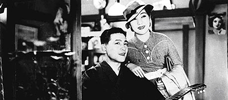
Wife! Be Like a Rose!
1935 -
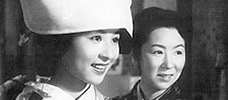
Mother
1952 -

Older Brother, Younger Sister
1953 -

The Sound of the Mountain
1954 -

Floating Clouds
1955 -
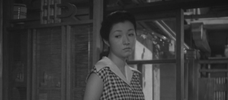
Flowing
1956 -

Summer Clouds
1958 -
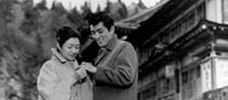
Yearning
1964 -
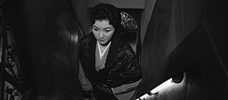
When a Woman Ascends the Stairs
1960 -

Repast
1951
We don’t do comments anymore, but you may contact us here or find us on Twitter or Facebook.



